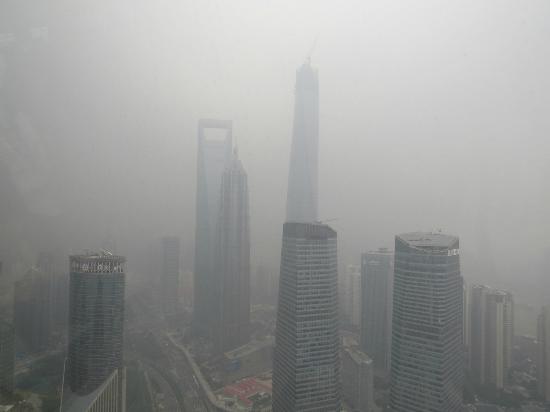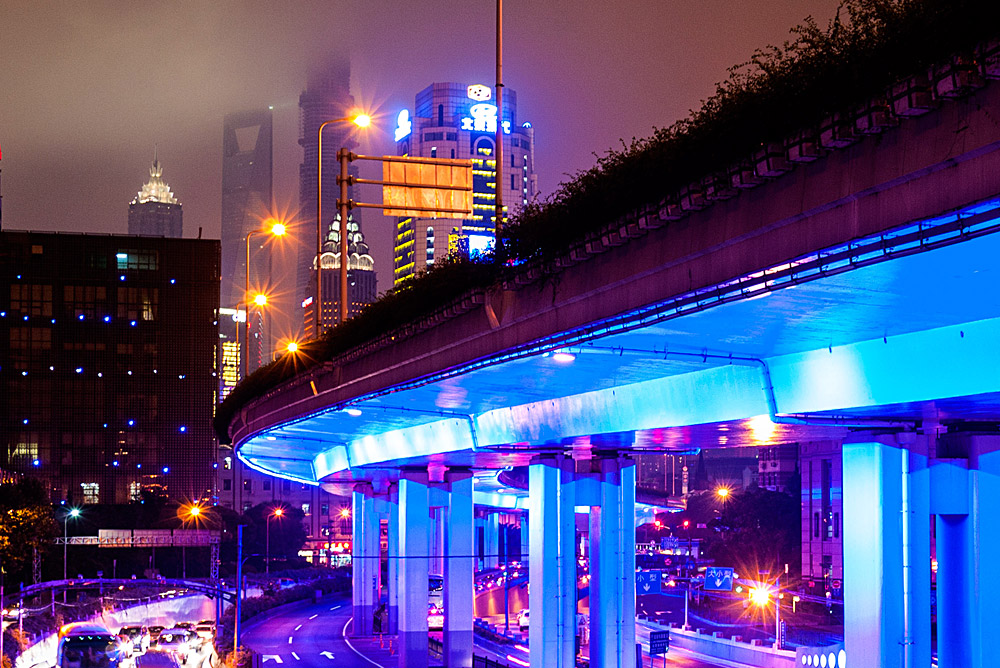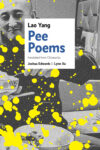 The most cynical feature of Shanghai’s futurist built environment is the way smog, from the winter hours of five in the evening to two or so at night, becomes a defining part of the city’s aesthetic. During business hours the smog is dull and nightmarish, a glimpse into the banality of ecological devastation. But at night it stills the garishness of the alien, almost campy Pudong skyline. It subdues the neon flaring up and down the Pearl Tower — the monstrous, light, Disney-ish galactic set piece at the skyline’s fore — and makes the various lurid light constellations along the elevated road project their intensities through a dingy screen. The mysterious effect is called cyberpunk, though Shanghai is less of a cultural or architectural instance of the genre than an all-encompassing atmospheric one. Smog becomes cyberpunk at the intersection of street life, architecture, lightwork, the banishment of civic society, and the very gas itself.
The most cynical feature of Shanghai’s futurist built environment is the way smog, from the winter hours of five in the evening to two or so at night, becomes a defining part of the city’s aesthetic. During business hours the smog is dull and nightmarish, a glimpse into the banality of ecological devastation. But at night it stills the garishness of the alien, almost campy Pudong skyline. It subdues the neon flaring up and down the Pearl Tower — the monstrous, light, Disney-ish galactic set piece at the skyline’s fore — and makes the various lurid light constellations along the elevated road project their intensities through a dingy screen. The mysterious effect is called cyberpunk, though Shanghai is less of a cultural or architectural instance of the genre than an all-encompassing atmospheric one. Smog becomes cyberpunk at the intersection of street life, architecture, lightwork, the banishment of civic society, and the very gas itself.
For the past few months smog has been dropping in and out, staying for several days and then dissipating with the rain. Two or more polluted days in a row invariably cause me to fall ill. My throat gets sore but I find more to talk about — “I’d rather talk about the weather. / I’d rather talk about which airlines I prefer” — is how Frederick Seidel starts a stanza in his 2012 poem “The Lovely Redhead.” Chinese airlines are far superior and offer complimentary meals on two-hour flights from Shanghai to Beijing, and though I usually turn into Bartleby when given the chance to participate in public conversation, I’ve found a certain willingness to carry on talking about smog. It’s not quite the weather, and yet it is, and it’s at once more innocent and existential than debating politics, especially if you link it with both weather and how the planet’s getting warmer. The casualness of the interest is worrisome. Lately I’ve grown concerned that all the best poetry when the soft-sounding “climate change” turns into full on environmental collapse will be about the perverse contentment the more sardonic poets are able to extract from our inexorable decline. The calls to action will only become more stirring, but I’ll remain in bed, reading a new collection called Fantastic Weather by Frederick Seidel, who will be still alive in 2075, age 138, writing poems about going through airport security in a world that has warmed by 4 degrees Celsius.
For now, however, I remain in Shanghai, enwrapped in a soft blanket of pollution. Owen Hatherley, the polemical Marxist architecture critic, taught here recently and found the city “thrilling” at first but “disappointing” in the end. “It seemed like precisely the future I had imagined in childhood, but it was almost disappointing,” he said. What’s disappointing for him is how predictable Shanghai’s simulation of the future is, but it strikes me more as unflinching in the way it allows the cultural and environmental logics of today to play out. We thought the future would suggest the hysterics of a slightly sinister theme park, but did people back in the 1960s really know the aesthetic would include so prominently the imprint of environmental decay? Or that there would be alongside the hypermodern such an emphasis on nostalgia, on pastiche, by turns a charming and infuriating adoration of heritage architecture, as there is in the city’s former French Concession?
 I find that my attraction to Shanghai lies in how it forces on me a particular series of ambivalences. Even the elevated road system, my favorite part of the city, with pink and blue light shooting along the roads’ underbellies and raised walkways looping just below — it’s this that in part allows for the regrettable suburbanization of the city; it’s this that is really just a sublimation of the horrible highway system that still detracts from the modern American city; and it’s this that can serve as a symbol for the reason my window looks out on a day enshrouded by a motionless haze. A similar ambivalence or tonal variety describes Seidel’s oblique climate change poetry. In his verse the environment emerges in all its decadent despair (“The biosphere on a rotisserie emits a certain sound / That tells the stars that Earth was moaning pleasure while it drowned”), its matter-of-factness (“This has been the warmest Manhattan / Since temperatures have been recorded”), its playfulness (“The amorous white icebergs flash their brown teeth, hissing. / They’re watching old porn videos of melting icebergs, pissing”), or its more frequent invisibility. The range Seidel applies to climate change is the same you hear applied to pollution in Shanghai: serious/deathly/ critical/jokey/incidental/matter-of-fact. I wonder if the range obscures political action. Perhaps, but more likely it’s a socially therapeutic way of dealing with a problem whose political solution is obscured for more enduring reasons.
I find that my attraction to Shanghai lies in how it forces on me a particular series of ambivalences. Even the elevated road system, my favorite part of the city, with pink and blue light shooting along the roads’ underbellies and raised walkways looping just below — it’s this that in part allows for the regrettable suburbanization of the city; it’s this that is really just a sublimation of the horrible highway system that still detracts from the modern American city; and it’s this that can serve as a symbol for the reason my window looks out on a day enshrouded by a motionless haze. A similar ambivalence or tonal variety describes Seidel’s oblique climate change poetry. In his verse the environment emerges in all its decadent despair (“The biosphere on a rotisserie emits a certain sound / That tells the stars that Earth was moaning pleasure while it drowned”), its matter-of-factness (“This has been the warmest Manhattan / Since temperatures have been recorded”), its playfulness (“The amorous white icebergs flash their brown teeth, hissing. / They’re watching old porn videos of melting icebergs, pissing”), or its more frequent invisibility. The range Seidel applies to climate change is the same you hear applied to pollution in Shanghai: serious/deathly/ critical/jokey/incidental/matter-of-fact. I wonder if the range obscures political action. Perhaps, but more likely it’s a socially therapeutic way of dealing with a problem whose political solution is obscured for more enduring reasons.
Still, the range has a quality of the modern epic about it: the ability to shift between and realize at once the registers of comedy and tragedy. Perhaps then a tragi-comic future for cities in America and Europe will go something like this: smash down our austerity regimes; unleash a short, heady economic boom; erect wild yet predictable avant-garde skylines; and then return to our quiet, suburban mimickings of Victoriana to talk freely, pleasurably, somberly, and with wit about the state of ecology.
This post may contain affiliate links.








